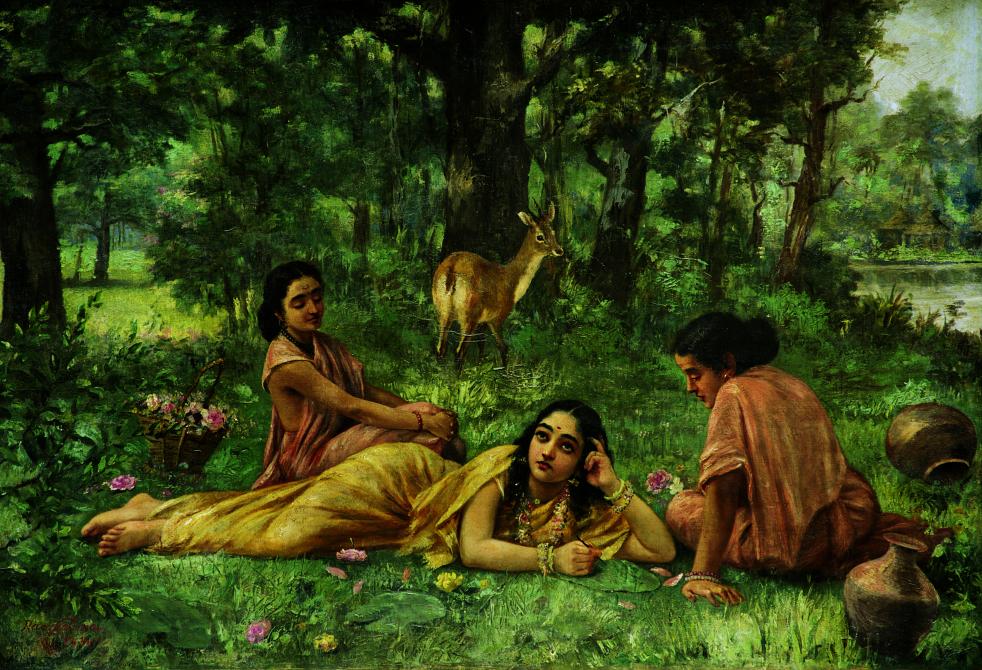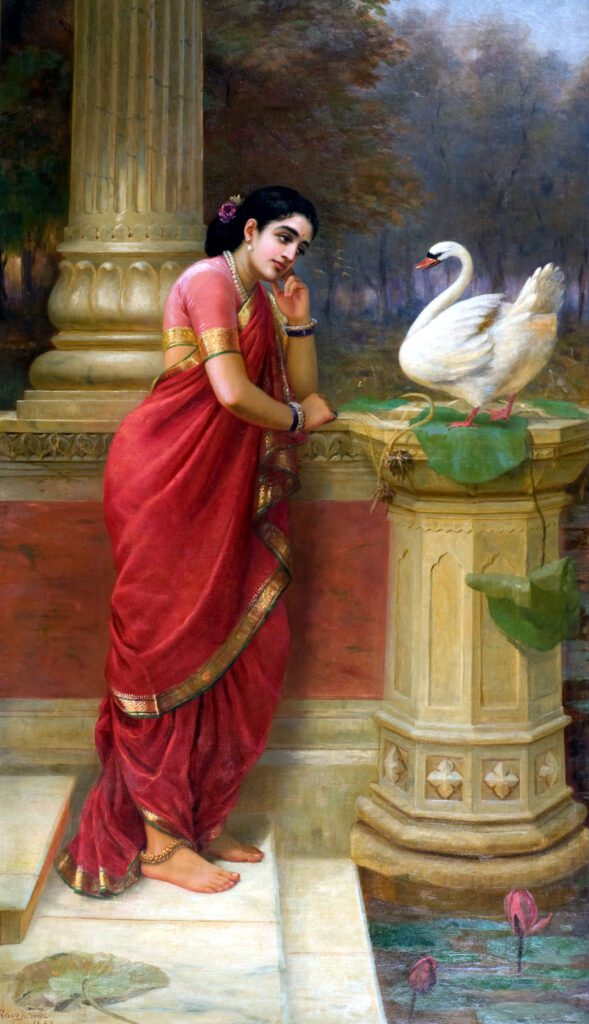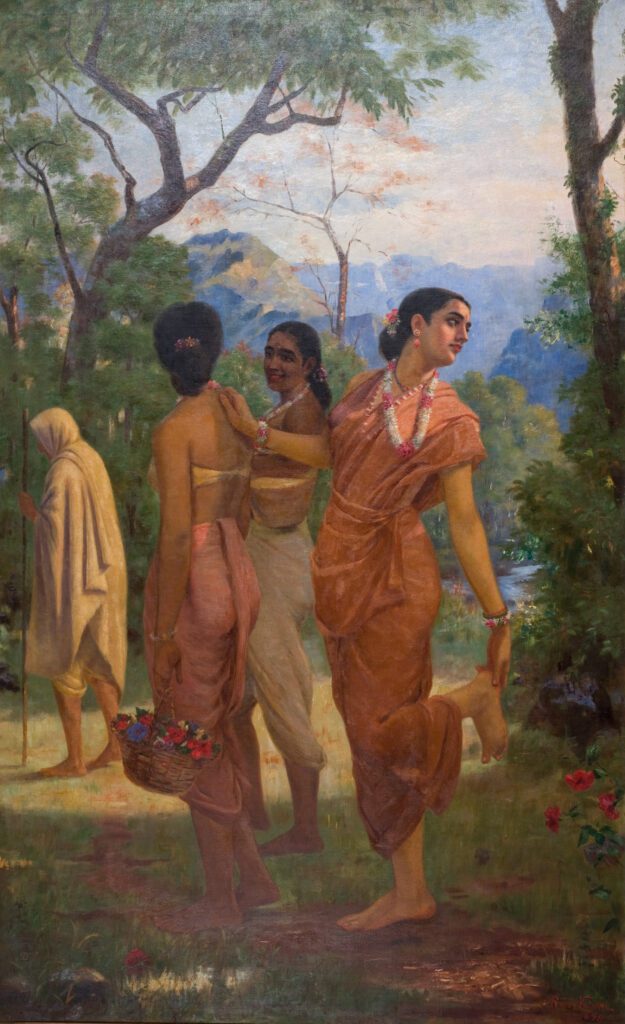Explore the allure of romance in Raja Ravi Varma’s paintings with our top picks, as we unveil the stories and passion behind his works. Delve into the emotional depths and cultural significance of these masterpieces that continue to resonate through time.
Table of Contents
Introduction to Raja Ravi Varma: Master of Romantic Indian Art
Raja Ravi Varma, an iconic figure in the Indian art scene, is renowned for his profound impact on painting, adeptly blending European techniques with Indian themes. Born in 1848 in Kerala, Varma was a pioneer who brought the narratives of Indian mythology and history to life through his vibrant oil paintings. His work stands out for its romantic depictions that capture complex emotions and cultural narratives, making them resonate deeply with a diverse audience.
Varma’s romantic paintings are particularly celebrated for their vivid portrayal of love, longing, and devotion. Works like “Shakuntala Patra Lekhan” and “Radha in Moonlight” are prime examples of his skill in capturing the essence of romantic folklore with a profound emotional and visual appeal. These paintings not only depict the beauty of mythological figures but also reflect the everyday emotions that touch the viewer’s heart.
Nobel laureate Rabindranath Tagore praised Varma’s work, stating, “The secret of Ravi Varma’s appeal is in reminding us how precious our own culture is to us, restoring our inheritance.” Art historian Tapati Guha-Thakurta admired the emotional depth in his paintings, noting, “This very gesture – the twist and turn of the head and body – draws the viewer into the narrative, inviting one to place this scene within an imagined sequence of images and events.”
As we explore 10 of the most Romantic Raja Ravi Varma Paintings, each masterpiece will be highlighted for its unique story and artistic merit, showcasing Varma’s unparalleled skill and deep understanding of human emotions and cultural narratives. These works are not just visually stunning but are gateways to the rich tapestry of Indian storytelling traditions, promising a captivating experience for art lovers and cultural enthusiasts alike.
Top 10 Romantic Paintings by Raja Ravi Varma
1. Shakuntala Patra Lekhan (1876)

- Description: “Shakuntala Patra Lekhan,” crafted by the eminent Raja Ravi Varma in 1876, is an oil painting steeped in the lush verdure of an idyllic forest setting. The artwork captures a moment of tranquil introspection as Shakuntala, draped in a vibrant golden saree that glimmers against the backdrop of greenery, is depicted pensively engaging in the act of writing a letter. Surrounded by her companions in a serene natural locale, the painting is alive with a harmony of vibrant colors and palpable stillness that is both intimate and expansive.
- Symbolism and Themes: This painting is rich in romantic symbolism, portraying Shakuntala, a prominent figure in Indian mythology, involved in the delicate task of composing a message to her beloved, King Dushyanta. The scene is charged with the emotional weight of longing and anticipation, themes central to many of Varma’s works. The presence of her companions and the inquisitive deer in the background may symbolize the interconnectedness of human emotions with nature, accentuating the naturalistic setting as a witness to human sentiment and romantic contemplation. The flora and fauna add layers of meaning, with blooming flowers often symbolizing love in bloom and the deer, an animal that traditionally symbolizes gentleness and vulnerability, echoing Shakuntala’s own delicate emotional state.
- Current Location: “Shakuntala Patra Lekhan,” is preserved in the Hemamalini and Ganesh Shivaswamy collection located in Bengaluru. This significant collection serves as a sanctuary for Varma’s art, allowing the public to witness the legacy of his romanticized visions of Indian mythology.
2. Lady in the Moon Light (1889)

- Description: “Lady in the Moon Light” by Raja Ravi Varma is a compelling portrait of a woman sitting elegantly on a rock by a river, as the moonlight bathes the scene in a soft, silvery glow. Painted in 1889, this work exemplifies Varma’s expertise in the use of light and shadow to create a serene yet poignant atmosphere. The subject, adorned in traditional Indian attire, gazes pensively into the distance, her contemplative expression suggesting an inner world of thought and emotion.
- Symbolism and Themes: The painting delves deep into the theme of romantic yearning, with the moonlight traditionally symbolizing love and the mysterious allure of the night. Her introspective gaze, directed away from the viewer, invites us to ponder the thoughts occupying her mind. This element of mystery, combined with the eloquent stillness of the scene, suggests a silent narrative of waiting or expectation, a common thread in the romantic tapestry of Varma’s works.
- Current Location: This remarkable piece of Ravi Varma’s romantic oeuvre is housed in the Sri Jayachama Rajendra Art Gallery, nestled in the historic Jaganmohan Palace of Mysore, Karnataka. There, “Lady in the Moon Light” continues to enchant visitors, serving as a luminous example of the artist’s mastery over the interplay of light and emotion.
3. Hamsa Damayanti (1899)

- Description: “Damayanti and the Hamsa” is a captivating creation by Raja Ravi Varma, depicting the tale of Princess Damayanti, who, in the midst of a royal setting, engages in a deep conversation with a celestial swan. Rendered in oil, the painting presents Damayanti in a regal stance, her posture reflective of poise and grace. The swan, a symbol of purity and spiritual connection in Indian mythology, appears to be imparting wisdom or a message, setting the stage for a fateful romance with Nala. Varma’s signature attention to realism and detail brings out the delicate intricacies of Damayanti’s attire and the architectural finesse of her surroundings.
- Symbolism and Themes: This painting is steeped in symbolic elements that represent the divine intervention in human affairs, as the Hamsa acts as a messenger between Damayanti and her love. The swan’s serene composure contrasts with Damayanti’s slightly anxious demeanor, reflecting the tension and excitement of new love. The tranquil waters and the twilight ambiance serve as a backdrop, enhancing the painting’s romantic and ethereal mood.
- Current Location: This painting graces the halls of the Sree Chitra Art Gallery, a treasure trove of classical art located in Thiruvananthapuram, Kerala. Visitors can behold this and other works by Varma, where they remain emblematic of India’s rich artistic heritage.
4. Shakuntala looking back to glimpse Dushyanta (1898)

- Description: Raja Ravi Varma’s “Shakuntala Looking Back to Glimpse Dushyanta” from 1898 is a masterful representation of longing and unspoken love. The painting captures Shakuntala, as she walks through a verdant forest glade, turning her head for a fleeting glance in the direction she believes her beloved Dushyanta might appear. The elegance of her posture and the expectant look in her eyes are set against the natural beauty of the forest, where every element seems to be touched by the soft light of affection.
- Symbolism and Themes: The act of looking back in the painting is heavy with symbolism—indicative of Shakuntala’s mixed feelings of hope and uncertainty regarding her relationship with Dushyanta. The path she walks is not just a physical one, but also represents her emotional journey. The forest, traditionally a place of mystery and magic, becomes a witness to her inner turmoil, and the vibrant flora symbolizes the blooming of her love amidst uncertainty.
- Current Location: This poignant work is displayed at the Sree Chitra Art Gallery in Thiruvananthapuram, Kerala, allowing art enthusiasts to get a glimpse into Varma’s interpretation of classic Indian literature and the emotions that these epics stir within.
5. Stolen Interview (1848/1906)

- Description: “Stolen Interview,” attributed to the period between 1848 and 1906, is a profound depiction of intimate, silent dialogue. This oil on canvas by Raja Ravi Varma presents a woman examining a flower while a man watches her intently. The space between them, defined by the column’s shadow, creates a sense of distance yet intimacy, while the subdued tones and their attire reflect the period’s aesthetic.
- Symbolism and Themes: The painting’s title suggests a private moment shared with unspoken words—a ‘stolen’ slice of time where emotions are conveyed through gestures rather than speech. The flower in the woman’s hand may symbolize love’s delicate and fleeting nature, while the man’s pensive gaze captures the depth of his feelings. The architectural features lend a sense of stability, framing this moment of vulnerability and romantic tension.
- Current Location: “Stolen Interview” is housed at the Salar Jung Museum in Hyderabad, Andhra Pradesh, where it remains a testament to Raja Ravi Varma’s skillful portrayal of human emotions and romantic subtlety. Visitors can view this painting among other notable works of art that celebrate the richness of India’s cultural history.
6. Nala and Damayanti

- Description: Raja Ravi Varma’s painting “Nala and Damayanti” brings to life an epic moment from the Mahabharata with his characteristic realism infused with a romantic sensibility. The artwork vividly portrays Damayanti lying on a rock in a forest, her expression one of deep slumber or sorrow, as Nala looks upon her with a complex mix of emotions. The forest setting is rendered with intricate detail, from the texture of the bark on the trees to the dappled light filtering through the canopy, adding to the scene’s intensity.
- Symbolism and Themes: The story of Nala and Damayanti is a profound exploration of love, separation, and reunion, themes that Varma captures with emotional depth. Nala’s gaze upon the sleeping Damayanti symbolizes the trials and yearnings of love, while the forest represents the isolation and trials they endure. Their attire and the natural surroundings evoke the timelessness of their story, highlighting the enduring nature of love and fidelity.
- Current Location: This portrayal of “Nala and Damayanti” is preserved at the Maharaja Fateh Singh Museum located in the majestic Lakshmi Vilas Palace in Vadodara, Gujarat. The museum, renowned for its extensive collection of art, provides visitors with the opportunity to immerse themselves in Varma’s interpretation of this timeless love saga.
7. Vishwamitra and Menaka (1890)

- Description: In “Vishwamitra and Menaka,” Raja Ravi Varma paints a moment from an ancient narrative with dramatic flair. Created in 1890, this oil on canvas illustrates the sage Vishwamitra and the celestial nymph Menaka against a backdrop of a waterfall and lush forest. Menaka, draped in an ornate saree, offers a flower to Vishwamitra, whose expression is one of surprised enthrallment. The painting masterfully captures the tension between ascetic discipline and earthly temptation.
- Symbolism and Themes: The encounter between the meditative sage and the enchanting Menaka is rich with symbolism, representing the eternal play of spiritual ascension and the allure of sensual beauty. The waterfall in the background adds to the narrative tension, signifying both the natural flow of life and the potential for disruption. This artwork delves into the themes of temptation, divine distraction, and the power of beauty to sway even the most disciplined mind.
- Current Location: This captivating piece is a highlight at the Maharaja Fateh Singh Museum within the premises of Lakshmi Vilas Palace in Vadodara, Gujarat. The museum is home to an extensive collection of Raja Ravi Varma’s works, showcasing his pivotal role in defining Indian art aesthetics.
8. King Dushyanta Proposing Marriage with a Ring to Shakuntala

- Description: The evocative scene depicted in Raja Ravi Varma’s painting “King Dushyanta Proposing Marriage with a Ring to Shakuntala” captures a pivotal moment from the classic Indian epic, the Mahabharata. Varma’s oil on canvas illustrates King Dushyanta tenderly offering a ring to Shakuntala, symbolizing his proposal of marriage. The surrounding forest provides an intimate setting, with the deer beside them emphasizing the painting’s naturalistic and serene ambiance. Shakuntala’s gesture of holding Dushyanta’s arm indicates her acceptance and mutual affection.
- Symbolism and Themes: The proposal with a ring is symbolic of the union of two souls, a theme celebrated in many cultures. The presence of the deer, often a symbol of gentleness and innocence in Indian mythology, adds to the sanctity of the moment, suggesting approval from the natural world. This painting skillfully conveys the themes of love, commitment, and destiny which are central to their story.
- Current Location: While the original location of this painting is mentioned as part of the Wellcome Images collection, operated by the Wellcome Trust in the United Kingdom, its current display status is not specified. Wellcome Images hosts a vast historical collection, and this painting is among those that celebrate the rich tapestry of India’s cultural and mythological heritage
9. A Lady Playing Swarbat (1874)

- Description: “A Lady Playing Swarbat” is an enchanting 1874 work by Raja Ravi Varma, illustrating a poised woman engrossed in playing the swarbat, a traditional stringed instrument. Her sari is aglow with golden hues, complementing the deep blue of her blouse. The painting is suffused with a warm light that enhances her focused expression and the instrument’s delicate details. This piece is a testament to Varma’s ability to convey the beauty of Indian women and their cultural arts with grace and dignity.
- Symbolism and Themes: In this painting, Varma celebrates the cultural significance of music in Indian society. The lady’s absorbed demeanor suggests a deep connection to the music she is creating, symbolic of the harmony between tradition and personal expression. The instrument itself, the swarbat, is emblematic of the cultural richness of India. Through her, Varma may also be hinting at the broader role of women as custodians of tradition and artistry.
- Current Location: This mesmerizing piece resides within the walls of the Kowdiar Palace in Thiruvananthapuram, Kerala, bearing witness to the cultural legacy and sophisticated tastes of the royal family who once held court there.
10. Mohini on a swing (1894)

- Description: “Mohini on a Swing” is a striking 1894 painting by Raja Ravi Varma, representing Mohini, the enchanting female avatar of Lord Vishnu, in a moment of playful respite. Swathed in a flowing white sari, she swings gently against a backdrop of a lush and expansive landscape. The soft drapery of her clothing, combined with her relaxed yet alluring posture and the serene expression, captures the essence of feminine grace and the leisurely pace of traditional Indian life.
- Symbolism and Themes: The swing, a recurring motif in Indian art and literature, symbolizes the joy and innocence of love, often used to represent the flirtatious interplay between lovers. Here, Mohini’s solitary swing may indicate the captivating allure of the divine feminine, drawing in the onlooker with her beauty and poise. This piece evokes the themes of divine beauty and the playful nature of the gods in Hindu mythology.
- Current Location: The painting is a part of the esteemed collection owned by Ritu & P. Alak Gajapati Raju. The private nature of this collection means that viewing opportunities may be limited compared to public galleries, yet it highlights the continued appreciation and preservation of Raja Ravi Varma’s work within private collections.
Conclusion: The Lasting Legacy of Raja Ravi Varma
As we come to the close of our journey through the romantic vistas of Raja Ravi Varma’s artwork, it’s clear why he is celebrated as a cornerstone of Indian art history. Varma’s canvases, replete with the emotional depth and cultural richness, have left an indelible mark on the Indian art landscape. His paintings, more than just visual treats, are narrative masterpieces that weave together the threads of love, mythology, and tradition.
Ravi Varma was a trailblazer who melded European techniques with Indian sensibilities, bringing to life the stories and characters from epics and folklore that continue to resonate with audiences today. His romantic paintings are not mere illustrations but heartfelt expressions that capture the nuances of human emotions and the splendor of India’s past.
The cultural impact of his work is monumental, providing a window into the soul of an era where romance was interwoven with daily life and spirituality. Each portrait, each glance, and each gesture in his paintings carries the weight of a story, the warmth of an emotion, and the grace of a culture that cherishes its heritage.
For those who wish to delve deeper into the saga of Raja Ravi Varma’s contributions and explore how his works reflect India’s narrative, be sure to read our previous article on this luminary: 10 Raja Ravi Varma Paintings That Reveal India’s Story.
In the end, Raja Ravi Varma’s romantic paintings do more than just capture the eye; they captivate the heart, inviting us to experience the timeless beauty of Indian romance and the stories that will continue to be told for generations to come. His legacy, much like the love depicted in his artworks, is immortal—forever swaying in the hearts of art lovers around the world.
